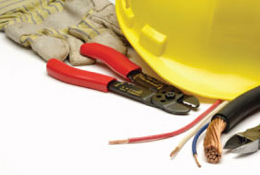When someone comes to your house and starts smashing down walls, tearing out appliances and crunching holes in ceilings, it’s best to know exactly who you are dealing with.
As a smart homeowner, you’ve already used Bankrate (www.bankrate.com) to lock in a low interest rate on a home equity loan and to find out which remodeling projects pay you back the most.
Now is no time to get nailed by a shoddy contractor
According to the U.S. Census Bureau, Americans spend more than $120 billion each year on home improvements, and little wonder. A 1997 American Housing Survey pinpointed the average age of the 64 million owner-occupied houses in the United States at 29 years, well ripe for any number of improvements.
So who is improving America’s homes? The National Association of the Remodeling Industry says professional contractors perform 78 percent of all remodels, with do-it-yourselfers hammering away at 18 percent and buy-it-yourselfers participating in 4 percent of the projects.
Lots of work means lots of contractors. And lots of ways to get scammed.
Slam the scam
Each year, home remodeling contractor problems rank among the top 10 consumer complaints to the Better Business Bureau. In fact, the BBB has received more than 7,000 complaints annually during the past decade. Americans lose an estimated $35 million each year to everything from shoddy workmanship to outright scams.
Holly Cherico, vice president of communications for the BBB, says there are three main reasons for the flood of complaints:
1. Homeowners don’t get all the details written into the contract before signing it.
2. Homeowners select a contractor based on price alone without investigating their background.
3. Homeowners get duped by outright scams.
These fly-by-night artists fall into three broad categories. There’s the con man, an outright criminal who promises anything at any price, demands his money up front and vanishes. Then there’s the lowball artist, a shady operator who intentionally bids below his legitimate competitors, then makes costly changes or skimps on workmanship to recoup a profit. Last, there’s the slipshod businessman whose intentions may be honorable but whose incompetent estimates and overall poor judgment end up costing you money.
“These are the door-to-door home contractors who claim to be doing a job at your neighbor’s house, they have leftover materials and would be happy to patch your leaky basement, repave your driveway or check your furnace,” says Cherico.
Protecting yourself against the con artist should be easy, she says. “Contact your local BBB and ask for a list of members in that industry. That’s just being a wise consumer,” Cherico says. “If you’re spending several thousand dollars, I think you want to make sure you’re giving it to a reputable company.”
Contracting 101
OK, you’ve successfully avoided the outright scam artists. But you’re not out of the woods yet. There are plenty of other ways your remodeling budget can head south — the first and perhaps most important being the failure to calculate an accurate budget in the first place.
To get a ballpark idea of what your project will cost, check out the national averages as compiled by Remodeling magazine. Adjust the ballpark cost slightly upward if you live in the East or West, slightly downward if you live in the Midwest or South. As a rule, you should adjust your total upward again if you live in a major metropolitan area.
A number of other Internet sites can also help you arrive at a more accurate budget for your remodeling project. One of the best is ImproveNet, which helps calculate the cost of labor and materials based on the size of your job.
Next, you need to determine which types of home professionals you’ll need to accomplish your remodel. For minor work, an experienced general contractor likely will be the most cost-effective. A specialized contractor, however, may save money over a general contractor by knowing the timesaving tricks of their particular specialty.
If major work is involved, especially if there are design, aesthetic or structure issues, an architect may be needed to draw up detailed plans and obtain permits. To save on costly architectural fees, consider instead a certified or licensed designer, who generally specializes in particular types of projects (kitchens, interiors, baths, etc.). Or consider a through from start to finish.
A ‘good sense’ list
To save headaches later, consider drawing up a short list of qualified professionals in your area by logging on to the National Association of the Remodeling Industry, the National Association of Home Builders RemodelorsTM Council or the Better Business Bureau. To help your search go smoothly, check out NARI’s detailed advice on “Selecting a Pro”.
It’s also good sense to make sure the contractor you choose has:
* Verifiable business licenses, certification and professional affiliations.
* Previous work experience, including a verifiable list of local customer references.
* Financial security — check banking and supplier references.
* Adequate insurance to protect you and your property against loss or suit.
* Good communication skills.
That last item should not be taken lightly. When you get down to writing the contract, clear communication on both sides is your single best insurance against a remodeling nightmare.
No-nonsense contract talk
Once you’ve solicited bids from several licensed professionals, studied them carefully and selected your contractor, it’s time to commit the project to paper. In general, remodeling contracts come in three flavors:
1. Cost Plus: You and your contractor arrive at an estimated cost and you agree to pay all actual costs plus the contractor’s fee. It’s a common type of bid, but you assume the risk of cost overruns and corrections.
2. Turnkey: The contractor commits to a fixed price for cost overruns. Change requests are documented, signed by both parties and typically paid for prior to the change being made.
3. Combination: If you choose to do part of the work yourself, you may combine elements of the cost plus and turnkey approach. The key is making each party’s responsibilities absolutely clear.
Your contract should include:
* Detailed descriptions covering all aspects of the work to be done.
* Remodeling plans signed by both parties.
* Payment plan (never pay more than 30 percent down).
* Start/finish dates.
* Change orders are to be approved by you before work is done.
* Final inspection and sign-off prior to final payment.
In addition, include these provisions:
* Cancellation rights: When you sign a remodeling contract, you have three business days to change your mind and cancel it. Contractors are required to tell you about this right and provide you with any cancellation forms.
* Lien protection: On large projects involving subcontractors, protect yourself from liens against your home in the event your primary contractor fails to pay the subs. This can be done by a release-of-lien addendum or by placing your payments in escrow until the work is finished.
* Permitting: It is the contractor’s responsibility to obtain building permits, if required, and to perform the work in accordance with all building codes.
* Warranty clause: Make sure all warranties on products and materials installed by your contractor are in writing and verified.
Control the quality
You’ve heard the old phrase “built to spec,” right?
Well, specifications, or specs, are written instructions detailing how the work on your project is to be completed, including installation processes, materials and actual products to be used. Without specs, a contractor is free to complete the work to their satisfaction, not yours.
If your project is a major one and your budget allows, have your architect include specs with your blueprint and hire a knowledgeable professional as your independent inspector to make sure the work is performed “to spec.”
Bottom line: The best-laid plans of home remodeling have a way of going awry without your watchful eye to oversee the process from start to finish. If you want it done right, hire a reliable professional, get everything in the contract, then watch over it like a hawk to make sure your contractor is performing quality work.
Then, of course, sit back and enjoy what you have caused to be done so well.










